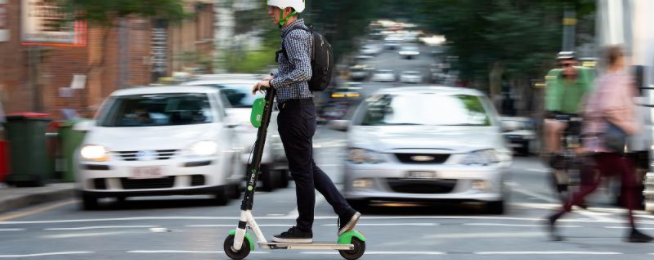A recent study into shared e-scooters schemes in a major university city has shown that the use of the devices reduces healthy active travel, especially walking and bike riding.
E-scooters are being trialled in a number of Australian cities under the assumption that they will reduce car trips and and ease traffic congestion.
Evidence is accumulating however that many e-scooter riders are on trips that otherwise would have been taken using active modes.
This has implications for transport and health planning that has been increasingly focused on shifting commuters to active modes so as to increase the level of physical activity in the community and reduce the burden of sedentary diseases such as diabetes.
An international research group looked at travel habits in Phoenix, Arizona, a major US city with a large student population.
Although research surveys have been reporting that e-scooting replaces walking and bicycling trips, potentially impacting physical activity (PA) levels, little is known about how e-scooter use objectively affects PA and how e-scooter use affects individual travel options in ways that could influence planning for active transportation.
In this study biometric data from smart watches was collected over five weeks during which e-scooter use was alternately allowed, prohibited, and allowed again in an “ABA” design.
The study also employed surveys and daily travel logs to gather information on travel behavior and per- ceptions of benefits and disbenefits related to e-scooter use.
The biometric data indicated that bicycling and walking trips are substantially more active than e-scooting or driving trips.
Self-reported trip data suggest that when e-scooters were allowed (Phases 1 and 3), e-scooter trips disproportionately replaced walking, bicycling, and/or e-biking trips, compared to auto trips.
However, when participants were prohibited from using e-scooters (Phase 2), 89% of trips were reported by automobile, complicating the story of trip substitution.
E-scooter responded that they value e-scooters for their convenience, affordability, speed, and fun.
Previous research has indicated that average e-scooter trips are about 1.5km, easily walkable or rideable distances, or tram or bus trips.
And e-scooter companies are concentrating their distribution in denser, more walkable and likeable areas.
This study found the length of scooter trips by participants to be identical to the length of walking and cycling trips.
"Given already inadequate amounts of PA, particularly in the U.S. and other auto-oriented countries, this potential PA loss due to replacing walking and biking with e-scooting is concerning, particularly if it occurs in clusters like on college campuses and in downtowns,” the study says.
This article was made possible by the support of Bicycle Network's members who enable us to make bike riding better in Australia.
Become our friend
Find out more about Bicycle Network and support us in making it easier for people to ride bikes.


